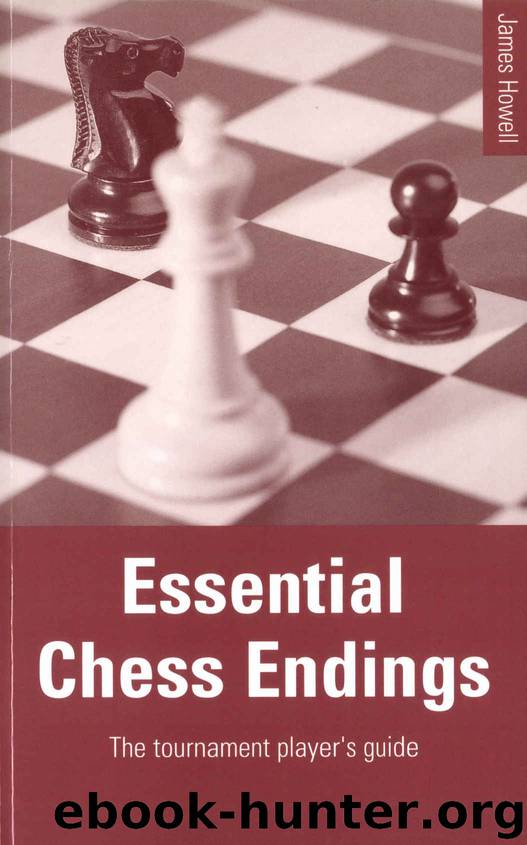Essential Chess Endings: The tournament player's guide by James Howell

Author:James Howell [Howell, James]
Language: eng
Format: azw3
Publisher: Batsford
Published: 2016-04-02T16:00:00+00:00
Hollis – Florian
7th Corr OL
Black to play draws but he does have to find the correct defensive plan.
8…f5?
Florian is following general principles in preparing to put his rook behind the passed pawn (at b5) but a more important factor is how his whole army co-operates. At some point Black will need to activate his king via f5 and g4 and it turns out that White can now prepare to answer …g4 with a check on the fourth rank followed by the crushing b4. Hollis had also worked out that 8…xg3 loses because of the difficulties Black has in bringing his rook back after 9 c7!. Then Black could even win a third pawn before having to give his rook up but unfortunately for him the resulting ending of rook against three connected passed pawns is lost. There was also a third (and correct) continuation which would have drawn although it might look unnatural to retreat the rook to a passive square in front of the pawn: 8…e3! 9 c7 e8 10 b7 b8 intending to swap the f-pawn for White’s g-pawn with …f5-g4. Hollis thought that this also lost but the great Russian endgame specialist Averbakh showed that Black could draw with a timely …g5. Even though this involves sacrificing a pawn, Black has to generate some counterplay and creating a passed h-pawn at the right moment is the only good way of doing this.
9 c7 b5 10 b7 e6
This is an admission that things are going wrong but Black loses after 10…f5 11 c3 g4 12 c4+ xg3 13 b4 he has to give up his rook, and his kingside pawns are too far back to trouble White.
11 c3 f6 12 c4 b1 13 c5 f5 14 d7! c1+
14…g4?! 15 d4+ and 16 b4 promotes the pawn without allowing Black the chance to give up his rook for it.
15 d6 b1 16 c7 c1+
These checks are double-edged because driving White’s king up the board does make promoting his pawn easier. On the other hand it also makes it harder for him to return in time to hinder Black’s kingside operations.
17 d8 b1 18 c8 g4 19 d6 g5 20 xf6 gxh4 21 gxh4 xh4 22 g6!
Slowing Black’s king and pawn down to a snail’s pace. This is the kind of finesse that is easier to find when you have days rather than minutes to ponder over a move.
22…h3 23 c7!
Threatening 24 b6.
Black now resigned since after the forced sequence 23…xb7+ 24 xb7 h4 25 c6 h2 26 d5 h3 27 e4 h1 28 f3 h2 White lifts the stalemate with 29 a6 and delivers mate next move.
These were four of the most thematic examples that I could find of White having an extra outside passed pawn but I wouldn’t necessarily claim that the 4-0 score in White’s favour is typical. Each game showed how White should be playing these positions but I have indicated in each case (apart from Polugaevsky-Vasiukov, which was completely lost in any case) how the defender should have made life harder.
Download
This site does not store any files on its server. We only index and link to content provided by other sites. Please contact the content providers to delete copyright contents if any and email us, we'll remove relevant links or contents immediately.
| Coloring Books for Grown-Ups | Humor |
| Movies | Performing Arts |
| Pop Culture | Puzzles & Games |
| Radio | Sheet Music & Scores |
| Television | Trivia & Fun Facts |
The Infinite Retina by Robert Scoble Irena Cronin(6156)
Harry Potter and the Cursed Child: The Journey by Harry Potter Theatrical Productions(4439)
The Sports Rules Book by Human Kinetics(4290)
Molly's Game: From Hollywood's Elite to Wall Street's Billionaire Boys Club, My High-Stakes Adventure in the World of Underground Poker by Molly Bloom(3485)
A Knight of the Seven Kingdoms by George R R Martin(3190)
Quidditch Through the Ages by J.K. Rowling(3062)
How To by Randall Munroe(3032)
Flowers For Algernon by Daniel Keyes(3019)
Quidditch Through the Ages by J K Rowling & Kennilworthy Whisp(2927)
Quidditch Through the Ages by Kennilworthy Whisp by J.K. Rowling(2812)
Stacked Decks by The Rotenberg Collection(2811)
Quidditch through the Ages by J. K. Rowling(2768)
Quidditch Through The Ages by J. K. Rowling(2729)
776 Stupidest Things Ever Said by Ross Petras(2693)
Ready Player One: A Novel by Ernest Cline(2647)
What If?: Serious Scientific Answers to Absurd Hypothetical Questions by Randall Munroe(2637)
Beautiful Oblivion by Jamie McGuire(2569)
The Book of Questions: Revised and Updated by Gregory Stock Ph.d(2516)
Champions of Illusion by Susana Martinez-Conde & Stephen Macknik(2414)
